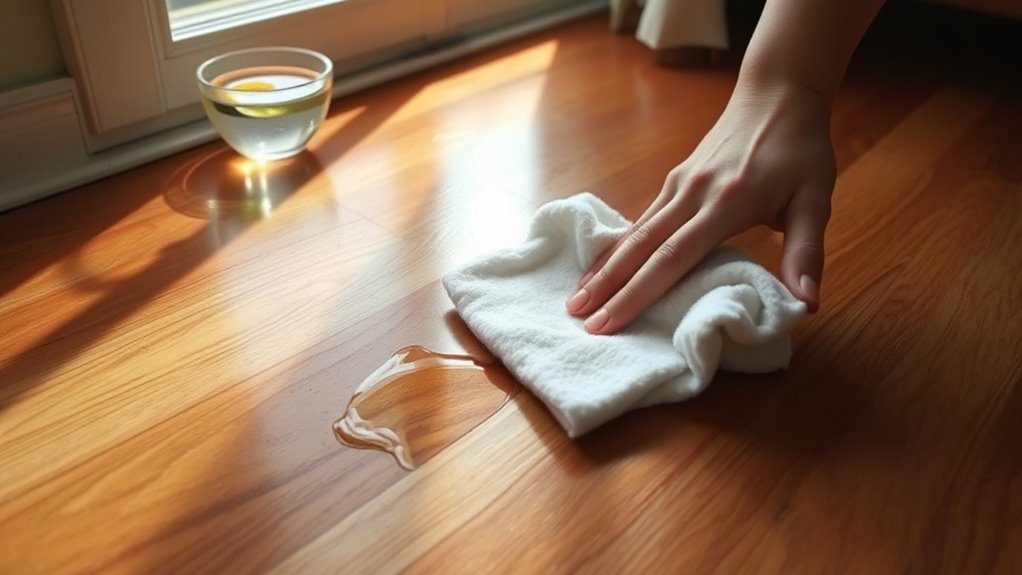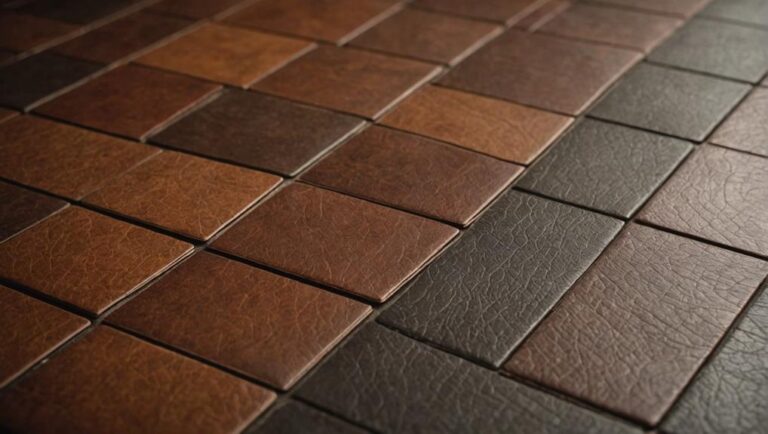To remove hardwood floor stains without sanding, first identify the stain type. Use a baking soda and water paste for surface stains or a low-heat iron wrapped in a cloth to lift water rings. For pet stains, apply enzymatic cleaners designed to break down odors and discoloration. Ink and paint stains require careful use of isopropyl alcohol or mild solvents. Protect finishes by testing products on hidden areas. More precise techniques and prevention tips can help maintain your floors effectively.
Identifying Different Types of Hardwood Floor Stains
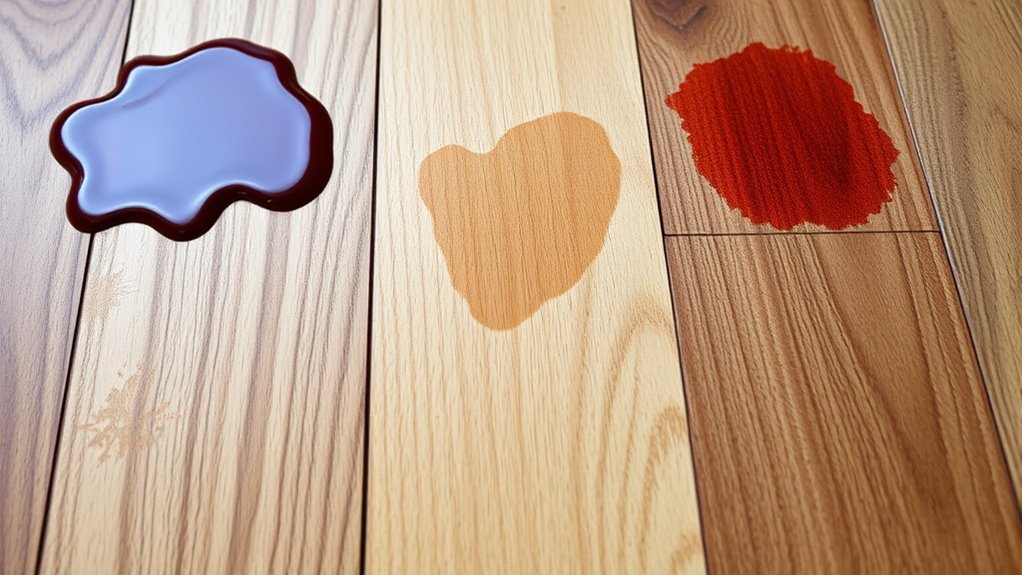
How can you accurately identify the type of stain on your hardwood floor? First, observe the stain’s color, texture, and location. Common stain types include water rings, oil-based spots, ink marks, and pet urine. Water stains often appear as white or cloudy patches, while oil-based stains are darker and penetrate deeper into the wood. Ink stains typically have sharp boundaries with intense color. Pet urine causes dark, sometimes black stains due to chemical reactions with the wood tannins. For precise stain identification, consider the stain’s age and exposure conditions, as older stains may have changed appearance. Accurate stain identification is essential for selecting the right removal method, ensuring you maintain your hardwood floor’s integrity and enjoy the freedom of a pristine living space.
Using Baking Soda and Water Paste for Surface Stains
Although surface stains on hardwood floors can be stubborn, a simple paste made from baking soda and water offers an effective and gentle cleaning solution. You can create this water paste by mixing baking soda with just enough water to form a spreadable consistency. Apply it directly to the stain, let it sit briefly, then gently rub with a soft cloth.
| Step | Material Needed | Action |
|---|---|---|
| 1 | Baking soda | Measure 2 tablespoons |
| 2 | Water | Add 1 tablespoon |
| 3 | Soft cloth | Apply and rub paste gently |
| 4 | Dry towel | Wipe off residue carefully |
This method preserves your hardwood’s finish, avoiding abrasion while lifting surface stains efficiently.
Removing Water Rings With Iron and Cloth Method
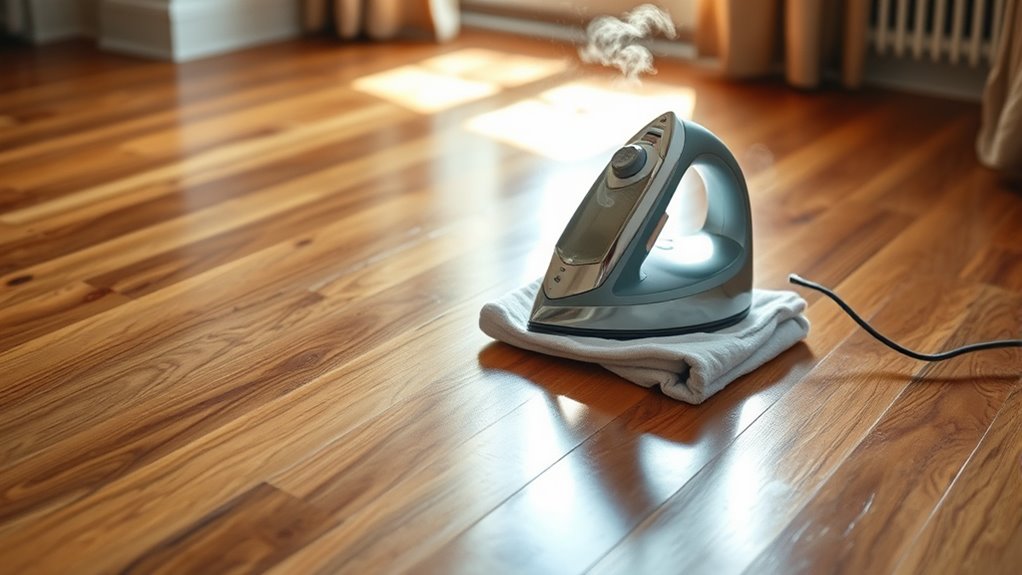
To remove water rings, start by setting your iron to a low heat without steam. Place a clean, dry cloth over the stained area to protect the wood from direct heat. Then, carefully apply the iron to the cloth in short intervals to lift the moisture trapped in the finish.
Preparing Iron and Cloth
Before you begin removing water rings with an iron and cloth, make certain your iron is set to a low heat without steam. Maintaining the correct iron temperature is vital; too high can damage your hardwood, while too low may be ineffective. Select a cloth type that is clean, white, and made of natural fibers such as cotton; avoid synthetic materials or colored fabrics that might transfer dyes or melt under heat. The cloth should be thick enough to provide a buffer between the iron and the wood surface, preventing direct contact. Confirm the cloth is dry and wrinkle-free to allow even heat distribution. Preparing both the iron and cloth properly sets the foundation for safely lifting water stains without sanding, preserving your floor’s finish and your freedom to restore it yourself.
Applying Heat Safely
When you apply heat using the iron and cloth method, it’s essential to move the iron continuously and avoid lingering in one spot to prevent scorching the wood. Proper heat application requires using safe methods to protect your hardwood floor’s finish and avoid damage. Here’s how to proceed effectively:
- Use a clean, damp cloth between the iron and the floor to diffuse heat evenly and shield the surface.
- Set the iron to a low or medium heat setting; high heat increases the risk of burning the wood.
- Keep the iron moving in small circular motions for brief intervals, checking frequently to assess progress.
Treating Pet Stains With Enzymatic Cleaners
Although pet stains can penetrate deeply into hardwood floors, enzymatic cleaners offer a specialized solution by breaking down the organic compounds responsible for odors and discoloration. When you apply the enzyme application, it targets proteins and uric acid, accelerating stain absorption and decomposition. Start by blotting the affected area, then generously apply the enzymatic cleaner, ensuring full saturation for maximum efficacy. Allow the cleaner to sit for at least 10 to 15 minutes to enable thorough enzymatic activity. Avoid rinsing immediately, as this can hinder the enzymes’ effectiveness. Repeated treatments may be necessary for older or severe stains. By leveraging enzymatic cleaners, you avoid sanding, preserving your floor’s integrity while restoring its natural finish and eliminating persistent pet stains and odors safely and effectively.
Applying Vinegar and Olive Oil for Light Marks
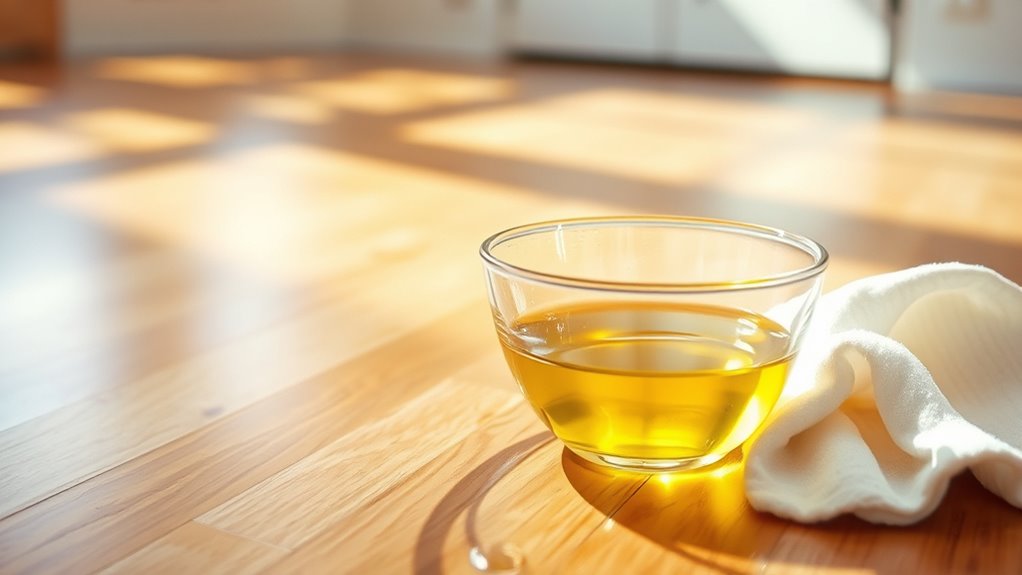
If you want to address light marks on hardwood floors without harsh chemicals, a mixture of vinegar and olive oil can be an effective solution. The vinegar benefits include gentle cleaning and mild stain removal due to its acidic nature, which breaks down dirt and light discolorations. Olive oil acts as a natural conditioner, restoring shine and preventing the wood from drying out.
To apply:
- Mix ½ cup vinegar with ½ cup olive oil for a balanced blend.
- Use a soft cloth dipped in the mixture to rub gently over stained areas.
- Buff the floor with a clean, dry cloth to enhance the finish and remove excess oil.
This method preserves your floor’s freedom from sanding while maintaining its natural beauty.
Using Commercial Hardwood Floor Stain Removers Safely
When selecting a commercial hardwood floor stain remover, choose a product compatible with your floor’s finish to avoid damage. Apply the remover precisely according to the manufacturer’s instructions, using appropriate tools to target the stain without spreading it. Always guarantee proper ventilation and wear protective gear to minimize exposure to harmful chemicals during the process.
Choosing the Right Product
Because hardwood floors can be sensitive to harsh chemicals, you’ll need to select commercial stain removers designed specifically for wood surfaces. The right product depends on the stain types you’re tackling and the cleaning agents’ compatibility with your floor’s finish. Look for products that balance effectiveness with preservation of wood integrity.
Consider these factors when choosing a stain remover:
- Targeted cleaning agents: Verify the formula is formulated for the specific stain type—oil, water, or organic.
- Finish compatibility: Confirm that the product won’t degrade polyurethane, varnish, or wax finishes.
- Safety certifications: Opt for removers with non-toxic, low-VOC labels for safer indoor use.
Application Tips and Techniques
Selecting the right stain remover sets the foundation for effective treatment, but applying it correctly guarantees the best results without damaging your hardwood floors. Always test the product on a hidden area to verify compatibility. Apply the remover sparingly with a soft cloth or applicator, following manufacturer instructions precisely. Avoid oversaturating the wood to prevent damage. Work in small sections, gently rubbing in circular motions to lift stains without abrading the finish. After treatment, promptly wipe away residue with a clean, damp cloth to maintain wood integrity. Consistent cleaning frequency helps minimize stain buildup, supporting long-term stain prevention. Regular maintenance combined with proper product application preserves your floor’s appearance, granting you the freedom to enjoy your space without resorting to sanding or refinishing.
Safety Precautions and Ventilation
Although commercial hardwood floor stain removers can be highly effective, you’ll need to follow strict safety precautions to protect yourself and your home environment. Always wear appropriate protective gear, including gloves and goggles, to prevent skin and eye irritation. Guarantee proper ventilation by opening windows and using fans to circulate fresh air, minimizing inhalation of fumes. Avoid confined spaces to reduce exposure risks.
Key safety measures include:
- Wearing chemical-resistant gloves and eye protection
- Operating in well-ventilated areas with multiple airflow sources
- Keeping children and pets away during application
Dealing With Ink and Paint Stains Without Sanding
Ink and paint stains on hardwood floors can be stubborn, but you don’t always need to resort to sanding to remove them. For effective ink removal, use isopropyl alcohol applied with a soft cloth, gently blotting the stain without spreading it. For paint cleanup, soften latex paint with warm soapy water and carefully scrape dried spots with a plastic scraper. Always test your cleaning agent on an inconspicuous area first.
| Stain Type | Recommended Method |
|---|---|
| Ink | Isopropyl alcohol |
| Water-based Paint | Warm soapy water + scraper |
| Oil-based Paint | Mineral spirits + scraper |
| Dried Paint | Gentle scraping + solvent |
These precise methods allow you to maintain your floor’s finish and avoid sanding.
Preventive Measures to Avoid Future Hardwood Floor Stains
Because hardwood floors are vulnerable to various stains, implementing preventive measures is essential to preserve their appearance and longevity. Prioritizing regular maintenance and applying protective coatings can greatly reduce the risk of future damage. You’ll want to establish a routine that minimizes exposure to liquids and abrasive materials.
Consider these key steps:
- Use area rugs or mats in high-traffic zones to prevent dirt and moisture buildup.
- Apply high-quality protective coatings like polyurethane to create a durable barrier against spills.
- Maintain a consistent cleaning schedule using appropriate, non-abrasive products to avoid surface wear.

